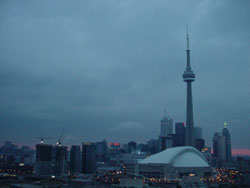About Everything
Necessitous News
Offsite Links
Comical Characters
Tresspass Act (Ont.)
Peregrination
»Buildings
Ontario
Barrie City Hall
Bell's Grist Mill
Brick Works
Rantech Station
Canadian Malting
Champlain Hotel
Colony Hotel
Hilton Hotel
Mayfield S.S.
Ontario Place
Thane Smelter
Royal York
Skydome
St. Joseph's
Union Station
Whitby Psych
Montreal
O'Keefe Brewery
U.S. Of A.
MCS
Ramada Inn
U of M
Storm Drains
Transit & Utility
Construction
Expeditions
Palavering
Sign Guestbook
View Guestbook

Every time you leave home, you see signs everywhere telling you where not to go: "Authorized access only", "Employees Only", "DANGER: 18,000 VOLTS" and the like. Obviously, all the best stuff is behind the doors such signs adorn -- and such is the premise for the exploration of buildings, both active and abandoned.
The approaches to exploring abandoned buildings and those still in use are wildly different but the basic concept is the same. All over our urban environment are doors, gates, and fences keeping us out of places we're not supposed to be. In our very own home towns, there are places we are coldly forbidden from entering, and discouraged from thinking too hard about. There are a few people who work at these places and know their secrets, but they're the exception rather than the rule. Why should we be kept out of the places that purport to serve us? When we sneak into these places right under the noses of an alert management, or climb the fences of an abandoned factory at midnight to explore its insides, we reclaim this space and make it ours once again. If these places have nothing to hide then they should keep no secrets, and it's these secrets that our exploration is directed towards.
 When one explores an active building the focus is usually on socially
engineering, avoiding authority or seeming inoccuous enough to be ignored.
One uses their wits and stealth to explore the off-limits, secret, and often
forgotten parts of active buildings without being apprehended, out of the
basic curious instinct of wanting to know what's behind every door.
When one explores an active building the focus is usually on socially
engineering, avoiding authority or seeming inoccuous enough to be ignored.
One uses their wits and stealth to explore the off-limits, secret, and often
forgotten parts of active buildings without being apprehended, out of the
basic curious instinct of wanting to know what's behind every door.
Abandoned buildings are entirely different -- they are far more dangerous,
more decrepit, and prone to a different sort of occupancy altogether. There
you worry not so much about being approached by someone who wants to know
if they can "help you" but rather being told on no uncertain terms by
permanent residents that you are unwelcome. You bring light sources, you
explore everything, you see as much as you can. Abandoned buildings contain
stories of the utility they once held and can be truly fascinating sites
that bear hours upon hours of exploration. That said, they are inherently
unsafe -- many have holes in floors, long drops, weak staircases, and other
such horrors. A good abandoned building is a fantastic thing to find but
once inside, you should take nothing for granted -- especially your safety.
It's easy to become comfortable with a hostile environment, but they have a
tendency to surprise you.
The exploration of buildings is driven by the need to know and the urge to
make forbidden space your own -- to become as familiar with your urban
surroundings as possible. In an abandoned building, you can be in the very
downtown core of a busy city at rush hour and still be the only person in
the entire structure. Some of these places are the most private places on
Earth, and the sensation of being there is indescribable. The basic need to
know what's on the floors a hotel elevator won't stop at and
what's behind the barbed wire surrounding an ancient industrial monument is
what compels us. As always, the risks can be high, so stay safe -- or, if
you can't take responsibility for yourself, stay home.
.